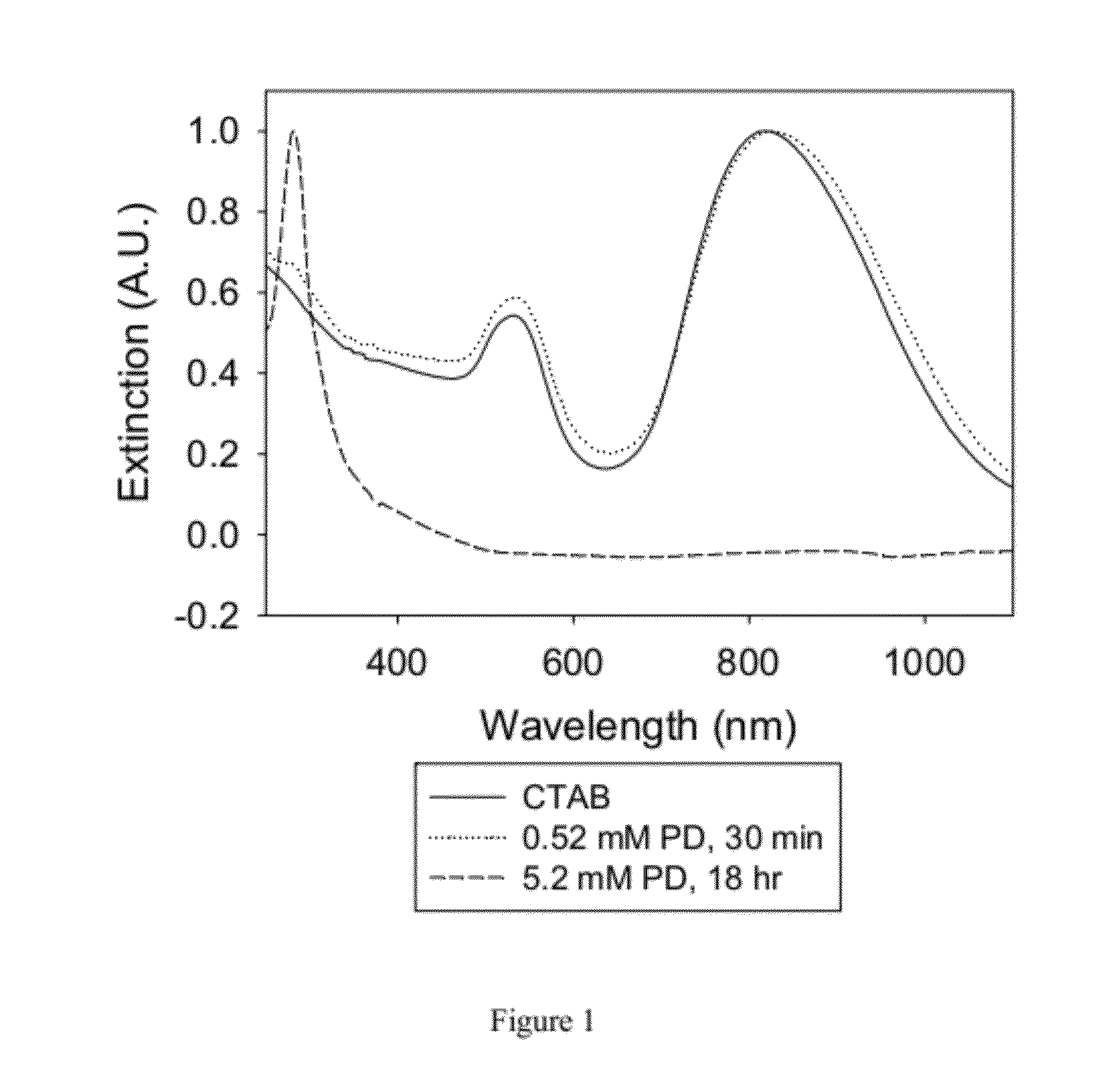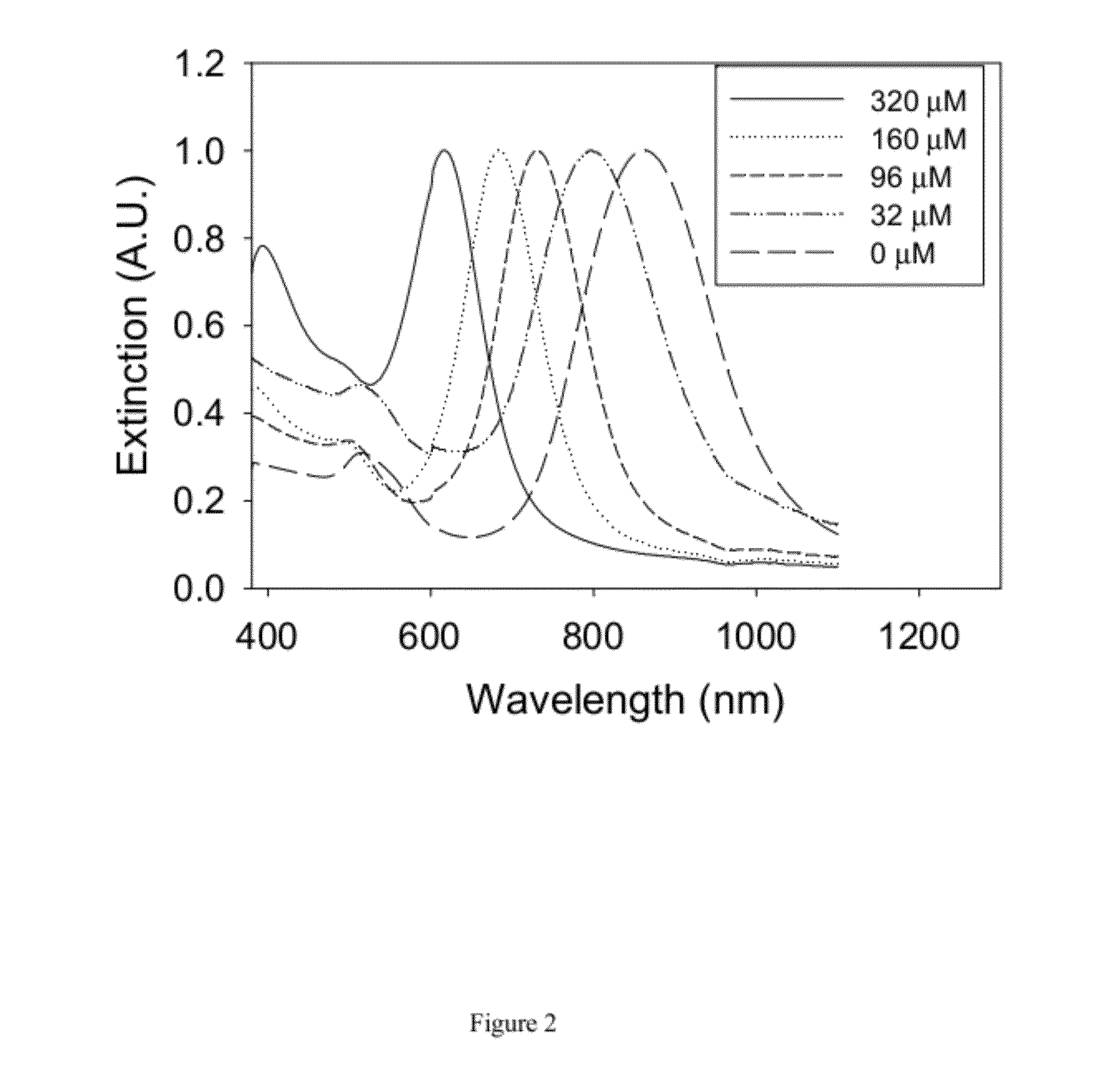Multifunctional Metal Nanoparticles Having A Polydopamine-Based Surface and Methods of Making and Using the Same
- Summary
- Abstract
- Description
- Claims
- Application Information
AI Technical Summary
Benefits of technology
Problems solved by technology
Method used
Image
Examples
example 1
Polydopamine-Based Assembly of Multifunctional, Multicomponent, Multimodal Metal Nanoparticles for Synergistic Photothermal Mediated Diagnosis and Therapy
[0068]In this example, we describe the coating of a polydopamine (PD) layer onto the surface of gold nanorods. We further describe modifications to the polydopamine surface of the nanorods in order to (1) immobilize silver into the surface to tune the surface plasmon resonance and the toxicity of the metal nanoparticles; (2) immobilize magnetic iron oxide nanoparticles into the layer to provide magnetic targetability; (3) react polyethylene glycol molecules into the layer with amine, thiol, catechol, and histidine functionalities to provide stealth characteristics, as well as provide proof of principle for diverse functionalization chemistry mediated by catechol oxidation to quinine; (4) immobilize chitosan onto the gold nanorods to provide additional molecular functionality; (5) react sugar-containing peptoids with catechol and am...
example 2
Polydopamine-Enabled Surface Functionalization of Gold Nanorods for Cancer Cell Targeted Imaging and Photothermal Therapy
[0113]In this example, we further describe the preparation and anticancer performance of PD coated NIR-active gold NRs. Anti-EGFR antibodies were conjugated to PD coated NRs and their use in targeted photothermal therapy of cancer cells was demonstrated. Antibody functionalized NRs were significantly more toxic to cancer cells in vitro compared to untargeted NRs when irradiated with a broadband light source. The example demonstrates that PD-mediated surface modification is a useful strategy for conjugation of cancer-specific ligands to nanoparticle surfaces, enabling the formation of biofunctional diagnostic and therapeutic metal nanoparticles.
[0114]Light sensitive nanoparticles have the potential to be used for anticancer therapy if they can be targeted to surface receptors of cancer cells. The aim of this example was to employ a novel biomimetic strategy for pre...
example 3
Plasmonic Heating Enhances Antibacterial Effect of Silver-Coated Gold Nanorods
[0166]In this example, polydopamine (PD) is used to coat gold nanorod (NR) surfaces and deposit silver in order to tune SPRs and provide antibacterial functionality. Antibacterial antibodies are reacted to PD surfaces through catechol redox reactions to provide biologically-specific targeting to bacterial cell walls. These multifunctional biomimetic metal NRs target both gram-negative E. coli and gram-positive S. epidermidis, providing contrast in optical imaging. Finally, light irradiation provides a potent therapeutic response to bacteria targeted with metal NRs, providing multiple mechanisms of action that includes cell-targeted photothermal heating and silver-based toxicity. The example demonstrates that catecholamine-based interfaces have the potential to form a broad range of biotargeted metal NPs for the diagnosis and treatment of antibiotic resistant bacterial infections and other diseases.
[0167]In...
PUM
 Login to View More
Login to View More Abstract
Description
Claims
Application Information
 Login to View More
Login to View More - R&D
- Intellectual Property
- Life Sciences
- Materials
- Tech Scout
- Unparalleled Data Quality
- Higher Quality Content
- 60% Fewer Hallucinations
Browse by: Latest US Patents, China's latest patents, Technical Efficacy Thesaurus, Application Domain, Technology Topic, Popular Technical Reports.
© 2025 PatSnap. All rights reserved.Legal|Privacy policy|Modern Slavery Act Transparency Statement|Sitemap|About US| Contact US: help@patsnap.com



